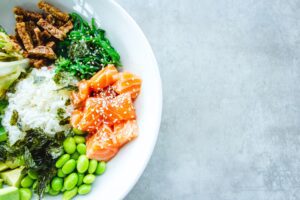Oils rich in polyunsaturated fatty acids (PUFAs) have been acknowledged to have great health benefits. For the last three decades, human nutrition research has been heavily focused on establishing the beneficial aspects of PUFA oils on human physiological functions and huge volumes have been written. The essential PUFAs of the n-3 and n-6 families are the precursors of prostanoids and eicosanoids of a variety of structures and functions.
Fish oils and other marine oils are rich in long chain polyunsaturated n-3 fatty acids (LCPUFA) such as eicosapentanoic acid (EPA) and docosahexanoic acid (DHA) and have antiatherosclerotic and hypotriglyceridemic effects3.
It has been stated that n-3 fatty acids have a direct effect on the heart muscle itself, increase the blood flow, decrease in arrhythmias, improve the arterial compliance and influence other cellular processes that are associated with heart functions.
Marine oils may also retard atherogenesis through their effects on platelet function and platelet-endothelial interactions.
Linoleic acid and alpha-linolenic acid (ALA) are converted to other.

long chain omega-6 and omega-3 fatty acids by metabolic pathways in mammals through enzymatic catalysis.
Yet mammals cannot synthesise these essential fatty acids in vivo and are thus dependant on external sources. alpha-linolenic acid is found in plants, phytoplankton, zooplankton and many marine species. In plants, a-linolenic acid is found in glycolipids in leaves while oils from seeds like flax, blackcurrant, rape, perilla and chia contain moderate to high amounts of alpha-linolenic acid. Soybeans, navy beans and walnuts are also sources of
alpha-linolenic acid.
Why follow nutrition diet
In modern western society, human diet is basically made up of wheat, maize, rice and a variety of pre-cooked or industrially fried food leading to relative deficiency of omega-3 polyunsaturated fatty acids compared with those of omega-6 ones. Coupled with lack of exercise, the huge intake of hydrogenated oils (and trans fatty acids there from) from various sources also significantly contributes to deterioration of human health. This imbalance of essential fatty acids, is worsened by consumption of meat from intensively reared farm animals who are fed with grain, relatively rich in n-6 PUFA rather than with wild plants with a high n-3 PUFA content. Even farmed fish
contain lower amounts of n-3 PUFA than those living wild.
Overall, the ratio of n-6./ n-3 PUFA in the modern diet is as high as 20-25: 1 instead of the ideal ratio of 1: 1.
THE RETURN OF OMEGA 3 FATTY ACIDS INTO THE FOOD SUPPLY
Omega-3 fatty acids must be incorporated into foods rather than be used solely as dietary supplement, which is a quasi-pharmaceutical approach.
Furthermore, the development of variety of omega-3 rich food stuffs would allow increased dietary intakes with little change of dietary habits. Omega-3 fatty acids can be brought back in our diet by using oils, rich in alpha-linolenic acid, avoiding vegetable oils rich in linoleic acid.
Use of vegetable oils rich in monounsaturated fatty acids (Oleic acid, C18: 1) e.g. rape seed oil also improve the n-6/n-3 ratio in our diet.



